Home
NEWS
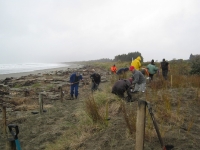
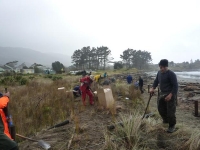 Eastern Earth has had an interesting 6 months becoming acquainted with Councils, landscapes, rivers and homes in the Hawkes Bay as well as servicing our usual clients along the East Coast. In August, Eastern Earth project managed a dune restoration project for the Wairoa District Council at Mahanga Beach, Mahia Peninsula in liaison with the Hawkes Bay Regional Council and the Department of Conservation. Although the spinifex planting was small in scale (owing to the poor strike of the locally-collected seed), it is seen as Stage 1 of a 3-year trial dune restoration there.
Eastern Earth has had an interesting 6 months becoming acquainted with Councils, landscapes, rivers and homes in the Hawkes Bay as well as servicing our usual clients along the East Coast. In August, Eastern Earth project managed a dune restoration project for the Wairoa District Council at Mahanga Beach, Mahia Peninsula in liaison with the Hawkes Bay Regional Council and the Department of Conservation. Although the spinifex planting was small in scale (owing to the poor strike of the locally-collected seed), it is seen as Stage 1 of a 3-year trial dune restoration there.
 November saw the completion of the landscape redevelopment at the Deanery, St John’s Cathedral, Napier for which Eastern Earth had prepared the design concepts. Involving a significant initial demolition of complex grottos, garage and storage sheds built into the concrete retaining wall on site, the redesign comprises a new outside hospitality deck area enhancing the busy socialising that takes place at the Deanery. The construction project was managed by Opus.
November saw the completion of the landscape redevelopment at the Deanery, St John’s Cathedral, Napier for which Eastern Earth had prepared the design concepts. Involving a significant initial demolition of complex grottos, garage and storage sheds built into the concrete retaining wall on site, the redesign comprises a new outside hospitality deck area enhancing the busy socialising that takes place at the Deanery. The construction project was managed by Opus.
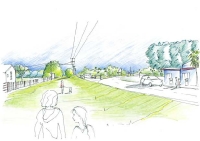 December saw the opening of the Opoutama Gateway road at Mahia – a re-alignment that has been eagerly anticipated by the local tangata whenua. Eastern Earth was a part of the consenting team for this project.
December saw the opening of the Opoutama Gateway road at Mahia – a re-alignment that has been eagerly anticipated by the local tangata whenua. Eastern Earth was a part of the consenting team for this project.
EVENTS
Two highlights in recent months couldn’t have been more different from each other. The first involved attendance at the William Colenso bi-centenary conference (http://williamcolenso.co.nz/) in Napier where a varied group of people passionate about his life and work gathered to celebrate his ‘polymath’ personality including (from a landscape perspective) his impressive pioneering exploration through the Ruahine ranges west of Napier, his avid collection and identification of native plant material (including the native orchids) and his prodigious correspondence with the Hookers of Kew Garden, particularly over plant classification. The launch of Peter Well’s book ‘A Hungry Heart’ was a conference highlight, with his reading from Colenso’s diaries and his own ‘writing journey’ with Colenso providing a poetic counterpoint to the academic Conference proceedings. I was interested to learn from Colenso’s diary about the karaka trees that the Imperial army wastefully felled on the southern side of Scinde Island (now Bluff Hill) and have wondered where they stood? Of interest is the information that Colenso’s eye witness account of the signing of the Treaty of Waitangi, (including his recording of who said what), is apparently one of the most authentic accounts from the pakeha perspective of the Treaty signing in existence. The Napier library has a copy of this record in its Reserve collection.

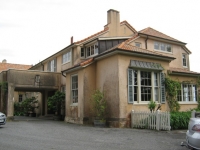 Of a totally different nature was the NZ Historic Places bus trip in November to see some of the architecture of William H Gummer. We visited three of his properties: Te Mata, Belmount and Tauroa. We also visited the Kopanga property designed by J A Louis Hay. Tauroa is exquisitely proportioned and the detailing to ceilings, lights, doors, and the staircase are breath-taking not to mention the bespoke curved furniture!
Of a totally different nature was the NZ Historic Places bus trip in November to see some of the architecture of William H Gummer. We visited three of his properties: Te Mata, Belmount and Tauroa. We also visited the Kopanga property designed by J A Louis Hay. Tauroa is exquisitely proportioned and the detailing to ceilings, lights, doors, and the staircase are breath-taking not to mention the bespoke curved furniture!
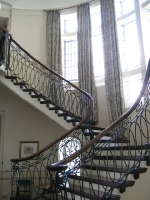
PLACES
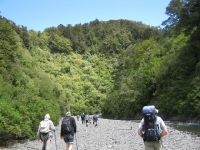
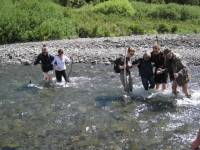 It was exhilarating to walk in the footsteps of William Colenso, early missionary and Napier civic figure following the Colenso Conference, when a group of us led by Mike Lusk, tramped to the Colenso monument up the Makaroro River. We certainly got a feeling for the number of river crossings Colenso must have made on each of these trips and we glimpsed some of the native orchids that excited him so passionately. He (and we) trod the pathway known to tangata whenua as their preferred route over the Ruahines.
It was exhilarating to walk in the footsteps of William Colenso, early missionary and Napier civic figure following the Colenso Conference, when a group of us led by Mike Lusk, tramped to the Colenso monument up the Makaroro River. We certainly got a feeling for the number of river crossings Colenso must have made on each of these trips and we glimpsed some of the native orchids that excited him so passionately. He (and we) trod the pathway known to tangata whenua as their preferred route over the Ruahines.











